Rethinking Sense of Place Interpretations in Declining Neighborhoods: The Case of Ami-dong Tombstone Cultural Village, Busan, South Korea
Abstract
1. Introduction
1.1. Why Should we Make Sense of Places?
So I risk a general proposition: a good place is one which, in some way appropriate to the person and her culture, makes her aware of her community, her past, the web of life, and the universe of time and space in which those are contained.
1.2. How Can we Communicate “Sense of Place” Constructs through Physical Environments?
2. Methods
3. Case Study
3.1. Study Area
3.2. History of Ami-dong Tombstone Village
3.3. A Potpourri of Senses of Place—People-Centered Urban Regeneration
3.3.1. Affective Responses—Social Capital and Collective Efficacy
Sense of Community, Community Participation and Activity Support
By organizing community meetings on regular basis, we were able to identify the actual issues and concerns of the residents. The local leaders helped in gathering people for these meetings and soon we were able to successfully draw out proposals for regeneration interventions together with the residents.
We wanted to help our people and make our village a better place to live. The regeneration project really helped us in every possible way to achieve that. Today we are much more united, and our village looks a lot better than before.
3.3.2. Behavioral Responses—Place Restoration
Physical Improvement (Private Realm—Housing)
Physical Improvement and Personalization (Semi-Public and Public Realms)
This space has been useful especially for the elderly women… they use the space for daily purposes and for interacting with their friends. Even though it is a small space we are happy to get an additional square metre for ourselves.
Safety and Crime Prevention
The project made sure to increase surveillance and make the neighbourhoods brighter for safety purposes. Also, the demolition of some abandoned houses and strengthening of neighbourly relations… helped in creating a neighbourhood watch indirectly.
Conservation Strategy
3.3.3. Cognitive Responses—Physical Imageability
Place Theming
Our village history brings back painful memories … but it is the truth, and we would like to share our story with everyone. The new image has given us a way to do so.
Landmarks, Cultural Facilities and Public Art
Social Imageability—Festivals and Events
I personally feel proud of these children. They have changed a lot since the project helped them to do everything they wanted to. Now, they are actively being a part of every event in the village.
We are happy to see this change in our children’s perspective after the regeneration project. Our children are not embarrassed … but identify themselves as a part of the village. They participate and organize every event along with us.
4. Discussion
4.1. The Overall Process
4.1.1. Social Regeneration through Affective Response: Community Makes Everything Possible
The project has brought us together… today we are not just a community but a family. We meet daily, enjoy community activities and celebrate every event… small or big… together irrespective of age.
4.1.2. Physical and Economic Regeneration through Behavioral Response: Spaces of Everyday Life and Personalization
Even though outsiders might not view these spaces as a huge upgrade we believe these spaces have given us additional room for our residents. Also the village elderly frequently interact and look after each other through these tiny spaces.
4.1.3. Cultural Regeneration through Cognitive Response: Dark History Becomes a Public Asset
These changes have helped us to create a strong identity … we were always forgotten or hidden (prior)… even though we have a dark and sad history… we are proud to be residents of Ami-dong and this (new image) is the way to narrate our stories.
5. Conclusions
Author Contributions
Funding
Informed Consent Statement
Data Availability Statement
Acknowledgments
Conflicts of Interest
| 1 | The Korean word “Maeul” translates to “village” in English and is used in an urban context to designate neighborhoods in downtown areas. |
| 2 | “Wondosim” or the original city center of Busan, corresponds to the first settlement area of the city near the Busan Port. The origins of the city began during the Joseon dynasty and was later occupied by the Japanese in 1910. After the Korean War, this area served as a major commercial and industrial center for the city. In the 1990s, the development of the city shifted towards the east, and “Seomyeon” and “Haeundae” became the new commercial districts replacing the original city center. Presently, this area is known as the “old downtown of Busan”. |
| 3 | The tombstones of the deceased were erected on a large base under which the ashes were stored. After the Korean War, refugees obliterated the headstone and used the base as a plinth for constructing houses. |
References
- Beidler, K.; Morrison, J. Sense of place: Inquiry and application. J. Urban. Int. Res. Placemaking Urban Sustain. 2016, 9, 205–215. [Google Scholar] [CrossRef]
- Ouf, A. Authenticity and Sense of Place in Urban Design. J. Urban Des. 2001, 6, 73–86. [Google Scholar] [CrossRef]
- Carmona, M. Public Places Urban Spaces: The Dimensions of Urban Design, 3rd ed.; Taylor and Francis: New York, NY, USA, 2021. [Google Scholar]
- Mosler, S. Everyday heritage concept as an approach to place-making process in the urban landscape. J. Urban Des. 2019, 24, 778–793. [Google Scholar] [CrossRef]
- Sepe, M.; Pitt, M. The characters of place in urban design. Urban Design Int. 2014, 19, 215–227. [Google Scholar] [CrossRef]
- Lynch, K. A Theory of Good City Form; MIT Press: Cambridge, MA, USA, 1981. [Google Scholar]
- Alexander, C. The Timeless Way of Building; Oxford University Press: New York, NY, USA, 1979. [Google Scholar]
- Bachelard, G. The Poetics of Space; Beacon Press: Boston, MA, USA, 1969. [Google Scholar]
- Hauge, Å. Identity and Place: A Critical Comparison of Three Identity Theories. Archit. Sci. Rev. 2007, 50, 44–51. [Google Scholar] [CrossRef]
- Hanaw Mohammed, T. The impact of heritage decline on urban social life. J. Environ. Psychol. 2018, 55, 34–47. [Google Scholar]
- Scannell, L.; Gifford, R. The experienced psychological benefits of place attachment. J. Environ. Psychol. 2017, 51, 256–269. [Google Scholar] [CrossRef]
- Lewicka, M. Place attachment, place identity, and place memory: Restoring the forgotten city past. J. Environ. Psychol. 2008, 28, 209–231. [Google Scholar] [CrossRef]
- Twigger-Ross, C.; Uzzell, D. Place and Identity Processes. J. Environ. Psychol. 1996, 16, 205–220. [Google Scholar] [CrossRef]
- Carmona, M. Place value: Place quality and its impact on health, social, economic and environmental outcomes. J. Urban Des. 2018, 24, 1–48. [Google Scholar] [CrossRef]
- Kusenbach, M. A Hierarchy of Urban Communities: Observations on the Nested Character of Place. City Community 2008, 7, 225–249. [Google Scholar] [CrossRef]
- Lewicka, M. Place attachment: How far have we come in the last 40 years? J. Environ. Psychol. 2011, 31, 207–230. [Google Scholar] [CrossRef]
- Depriest-Hricko, L.; Prytherch, D.L. Planning and Sense of Place in a ‘Dying’ Downtown: Articulating Memories and Visions in Middletown, Ohio. J. Urban Des. 2013, 18, 145–165. [Google Scholar] [CrossRef]
- Yarker, S. Tangential attachments: Towards a more nuanced understanding of the impacts of cultural urban regeneration on local identities. Urban Stud. 2018, 55, 3421–3436. [Google Scholar] [CrossRef]
- Brown, B.; Perkins, D.; Brown, G. Place attachment in a revitalizing neighborhood: Individual and block levels of analysis. J. Environ. Psychol. 2003, 23, 259–271. [Google Scholar] [CrossRef]
- Mazumdar, S.; Mazumdar, S.; Docuyanan, F.; McLaughlin, C. Creating a Sense of Place: The Vietnamese-Americans and Little Saigon. J. Environ. Psychol. 2000, 20, 319–333. [Google Scholar] [CrossRef]
- Zhang, M.; Wu, W.; Zhong, W. Agency and social construction of space under top-down planning: Resettled rural residents in China. Urban Stud. 2017, 55, 1541–1560. [Google Scholar] [CrossRef]
- Silver, A.; Grek-Martin, J. Now we understand what community really means: Reconceptualizing the role of sense of place in the disaster recovery process. J. Environ. Psychol. 2015, 42, 32–41. [Google Scholar] [CrossRef]
- Boğaç, C. Place attachment in a foreign settlement. J. Environ. Psychol. 2009, 29, 267–278. [Google Scholar] [CrossRef]
- Scannell, L.; Gifford, R. Defining place attachment: A tripartite organizing framework. J. Environ. Psychol. 2009, 30, 1–10. [Google Scholar] [CrossRef]
- Relph, E. Place and Placelessness; Pion: London, UK, 1976. [Google Scholar]
- Stefanovic, I. Phenomenological Encounters with Place: Cavtat to Square One. J. Environ. Psychol. 1998, 18, 31–44. [Google Scholar] [CrossRef]
- Seamon, D.; Sowers, J. Place and Placelessness, Edward Relph. In Key Texts in Human Geography; Hubbard, P., Kitchin, R., Valentine, G., Eds.; Sage: London, UK, 2008; pp. 43–51. [Google Scholar]
- Cullen, G. The Concise Townscape; Van Nostrand Reinhold Company: New York, NY, USA, 1971. [Google Scholar]
- Fullilove, M. Psychiatric Implications of Displacement: Contributions From the Psychology of Place. Am. J. Psychiatry 1996, 153, 1516–1523. [Google Scholar] [CrossRef] [PubMed]
- Seamon, D. A way of seeing people and place: Phenomenology in Environment-Behavior Research. In Theoretical Perspectives in Environment-Behavior Research: Underlying Assumptions, Research Problems, and Methodologies; Wapner, S., Demick, J., Yamamoto, T., Minami, H., Eds.; Springer: New York, NY, USA, 2000; pp. 157–178. [Google Scholar]
- Manzo, L. Beyond house and haven: Toward a revisioning of emotional relationships with places. J. Environ. Psychol. 2003, 23, 47–61. [Google Scholar] [CrossRef]
- Lee, S.-K. Market Modernization and the Sense of Place Lost in Transformation. In Urban Renewal, Community and Participation: Theory, Policy and Practice; Clark, J., Wise, N., Eds.; Springer: Cham, Switzerland, 2018; pp. 111–123. [Google Scholar]
- Ruggeri, D. The ‘My Mission Viejo’ Project. Investigating the Potential of Photovoice Methods in Place Identity and Attachment Research. J. Urban Des. 2014, 19, 119–139. [Google Scholar] [CrossRef]
- Aravot, I. Back to Phenomenological Placemaking. J. Urban Des. 2002, 7, 201–212. [Google Scholar] [CrossRef]
- Jiven, G.; Larkham, P. Sense of Place, Authenticity and Character: A Commentary. J. Urban Des. 2003, 8, 67–81. [Google Scholar] [CrossRef]
- Mihaylov, N.; Perkins, D. Community Place Attachment and its Role in Social Capital Development. In Place Attachment: Advances in Theory, Methods and Applications, 1st ed.; Manzo, L., Devine-Wright, P., Eds.; Routledge: London, UK, 2013. [Google Scholar]
- Hui, E.C.; Chen, T.; Lang, W.; Ou, Y. Urban community regeneration and community vitality revitalization through participatory planning in China. Cities 2021, 110, 103072. [Google Scholar] [CrossRef]
- Baek, Y.; Jung, C.; Joo, H. Residents’ Perception of a Collaborative Approach with Artists in Culture-Led Urban Regeneration: A Case Study of the Changdong Art Village in Changwon City in Korea. Sustainability 2021, 13, 8320. [Google Scholar] [CrossRef]
- Rapoport, A. Human Aspects of Urban Form: Towards a Man-Environment Approach to Urban Form and Design; Pergamon Press: Oxford, UK, 1977. [Google Scholar]
- Rapoport, A. The Meaning of Built Environment: A Nonverbal Communication Approach; Sage Publications: Beverly Hills, CA, USA, 1982. [Google Scholar]
- Devine-Wright, P. Rethinking NIMBYism: The Role of Place Attachment and Place Identity in Explaining Place-protective Action. J. Community Appl. Soc. Psychol. 2009, 19, 426–441. [Google Scholar] [CrossRef]
- Manzo, L.; Perkins, D. Finding Common Ground: The Importance of Place Attachment to Community Participation and Planning. J. Plan. Lit. 2006, 20, 335–350. [Google Scholar] [CrossRef]
- OECD. Urban Regeneration and Land Use in Korea. In OECD, The Governance of Land Use in Korea: Urban Regeneration; OECD Publishing: Paris, France, 2019. [Google Scholar]
- Busan Metropolitan City. (2013, February). Sanbokdoro Renaissance Project. Available online: https://www.busan.go.kr/comm/getFile?srvcId=BBSTY1&upperNo=154860&fileTy=ATTACH&fileNo=1 (accessed on 18 June 2022).
- Woo, S.-K. Amidong Iyagi: Pogaejin Sam Gyopchojin Gonggan [The Story of Ami-dong: Overlapped Lives, Layered Space]; Gungnip Minsok Bangmulgwan [National Folk Museum of Korea]: Busan, Republic of Korea, 2020. [Google Scholar]
- Jin, E.; Lee, W.; Kim, D. Does Resident Participation in an Urban Regeneration Project Improve Neighborhood Satisfaction: A Case Study of “Amichojang” in Busan, South Korea. Sustainability 2018, 10, 3755. [Google Scholar] [CrossRef]
- KOSIS. (n.d.). Available online: https://kosis.kr/eng/ (accessed on 21 July 2022).
- Woo, S.-K. Amichojang Dosijaesaeng Peurojekteu [Ami-Chojang Urban Regeneration Project]; Soguchong Changjodosi [Seo-gu Creative City Department]: Busan, Republic of Korea, 2016. [Google Scholar]
- Jones, K.; Evans, J. Rescue Geography: Place Making, Affect and Regeneration. Urban Studies 2011, 49, 2315–2330. [Google Scholar] [CrossRef]
- Ng, M.K. Urban Renewal, Sense of Community and Social Capital: A Case Study of Two Neighbourhoods in Hong Kong. In Urban Renewal, Community and Participation; Clark, J., Wise, N., Eds.; The Urban Book Series; Springer: Cham, Switzerland, 2018. [Google Scholar] [CrossRef]
- Ng, M.K. Knowledge and power in regenerating lived space in Treasure Hill, Taipei 1960s–2010: From squatter settlement to a co-living artist village. Plan. Perspect. 2015, 30, 53–270. [Google Scholar] [CrossRef]
- Inui, K. Chiisana Fuukei Kara no Manabi- Samazama na Sabisu no Hyoujou [Little Spaces]; TOTO Shuppan: Tokyo, Japan, 2014. [Google Scholar]
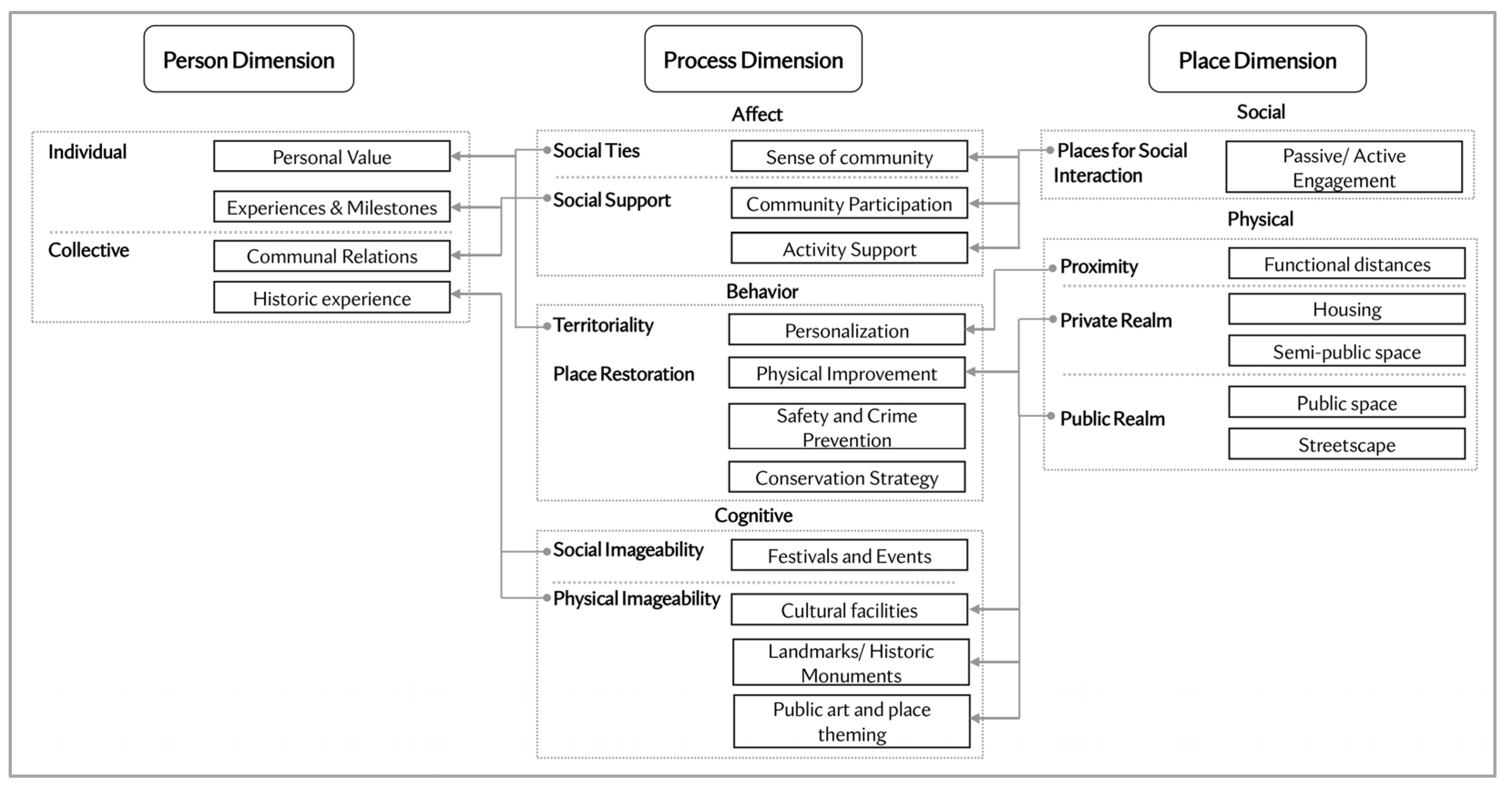
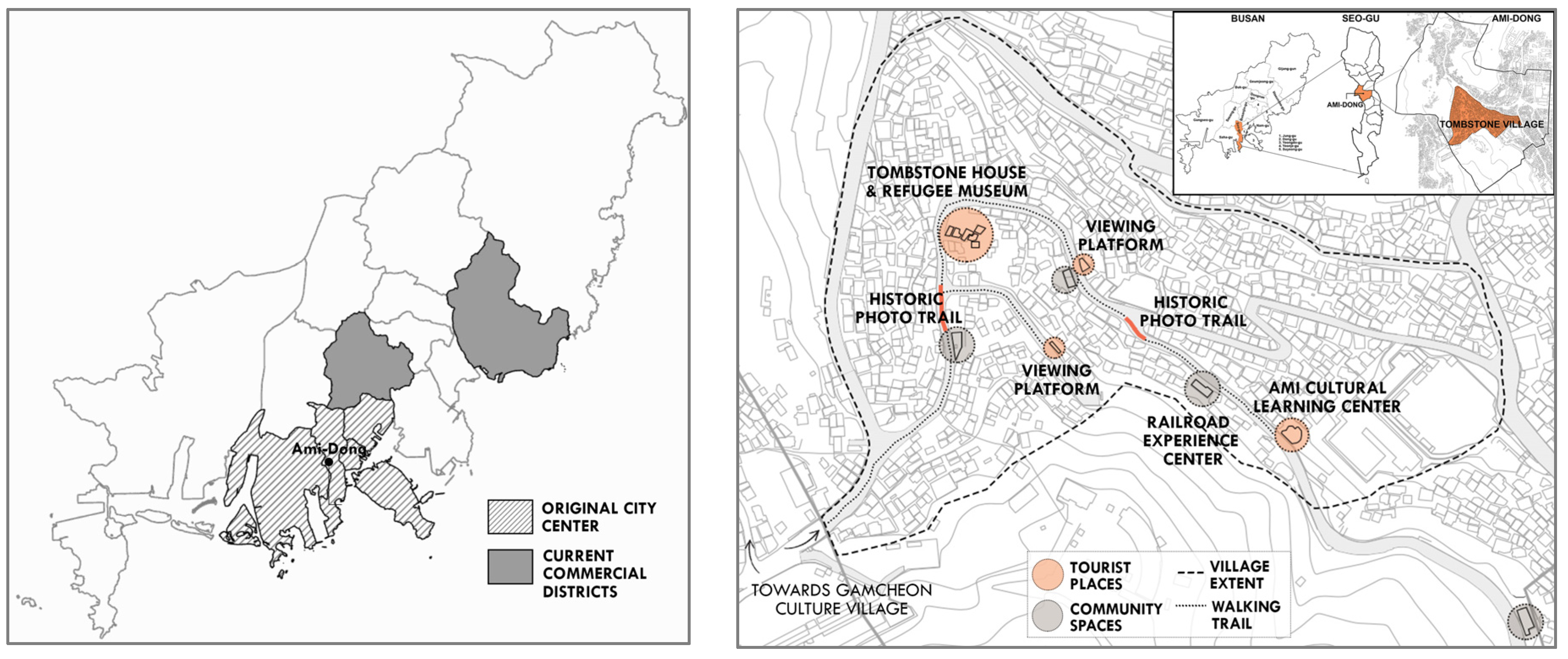
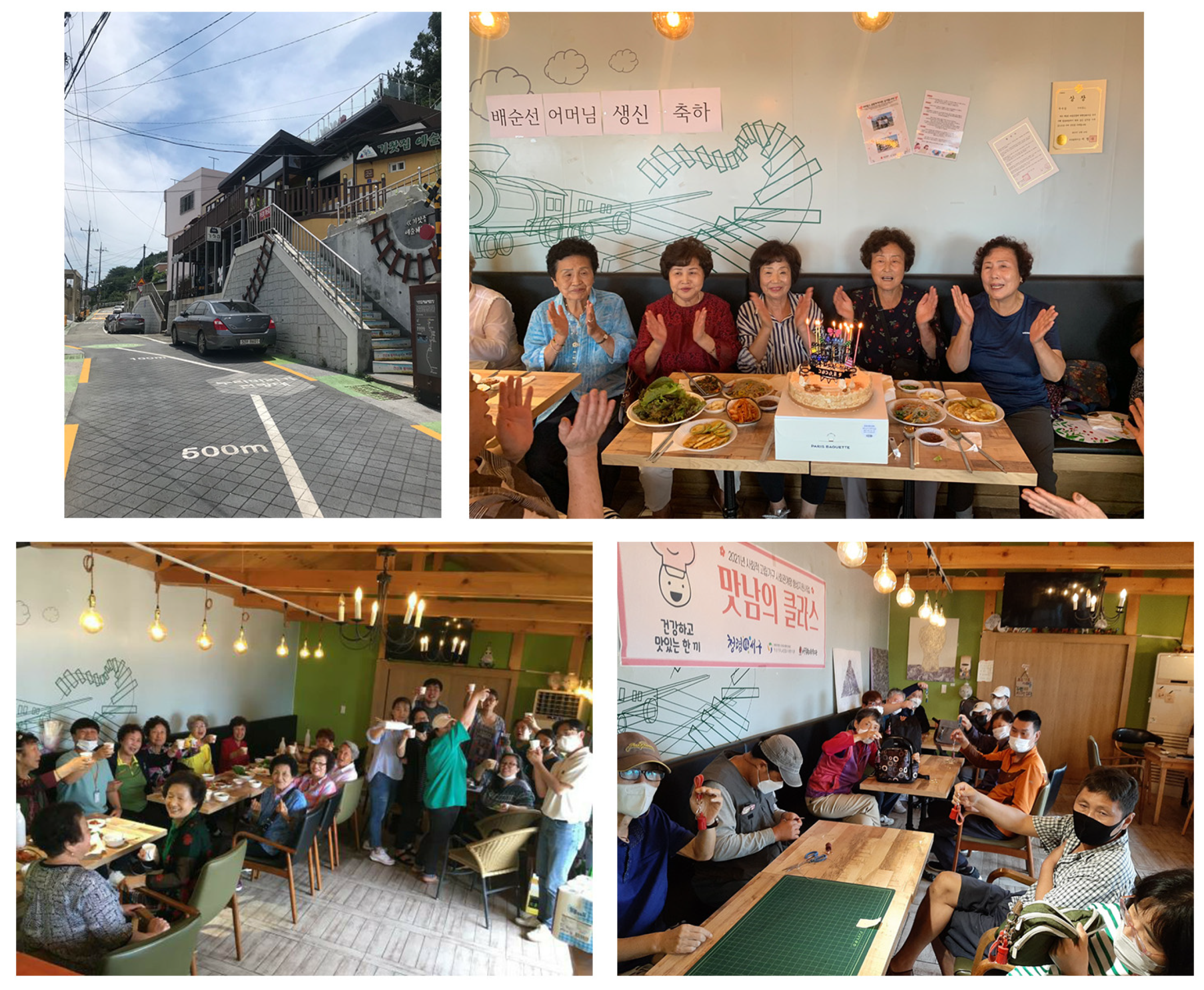
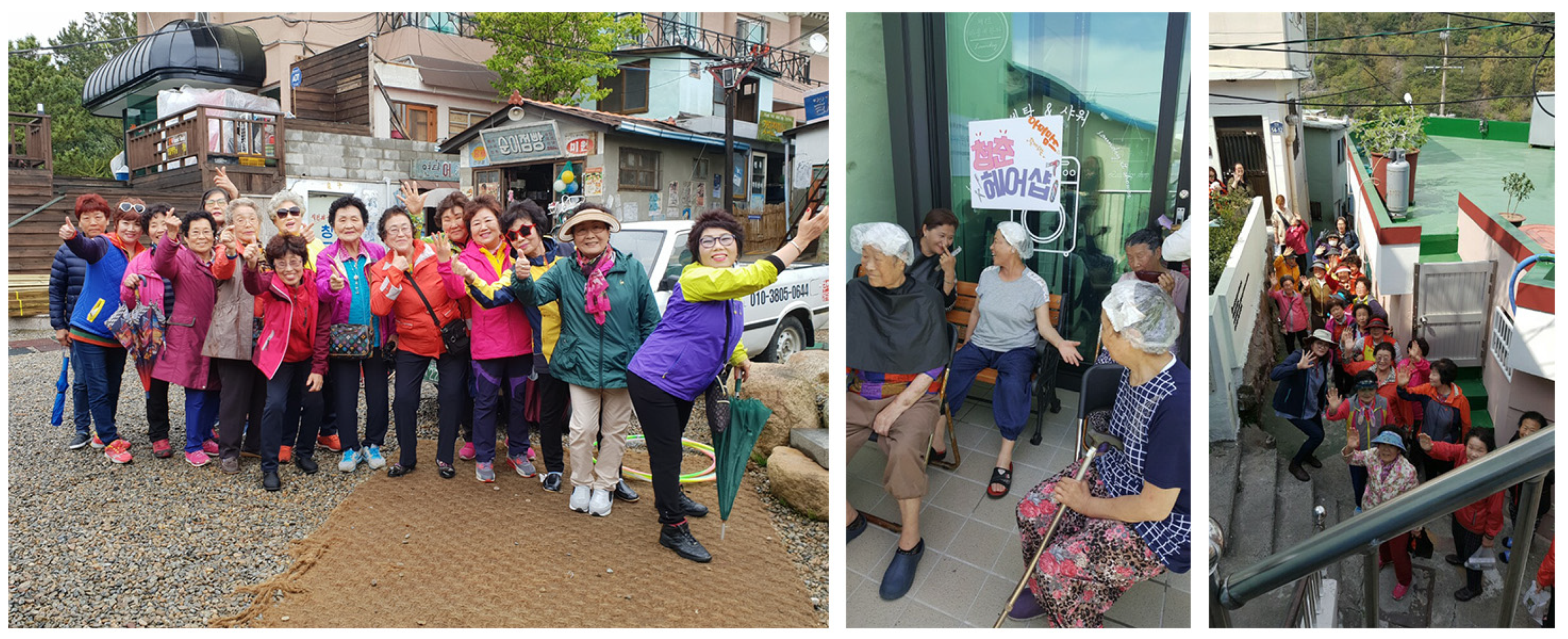
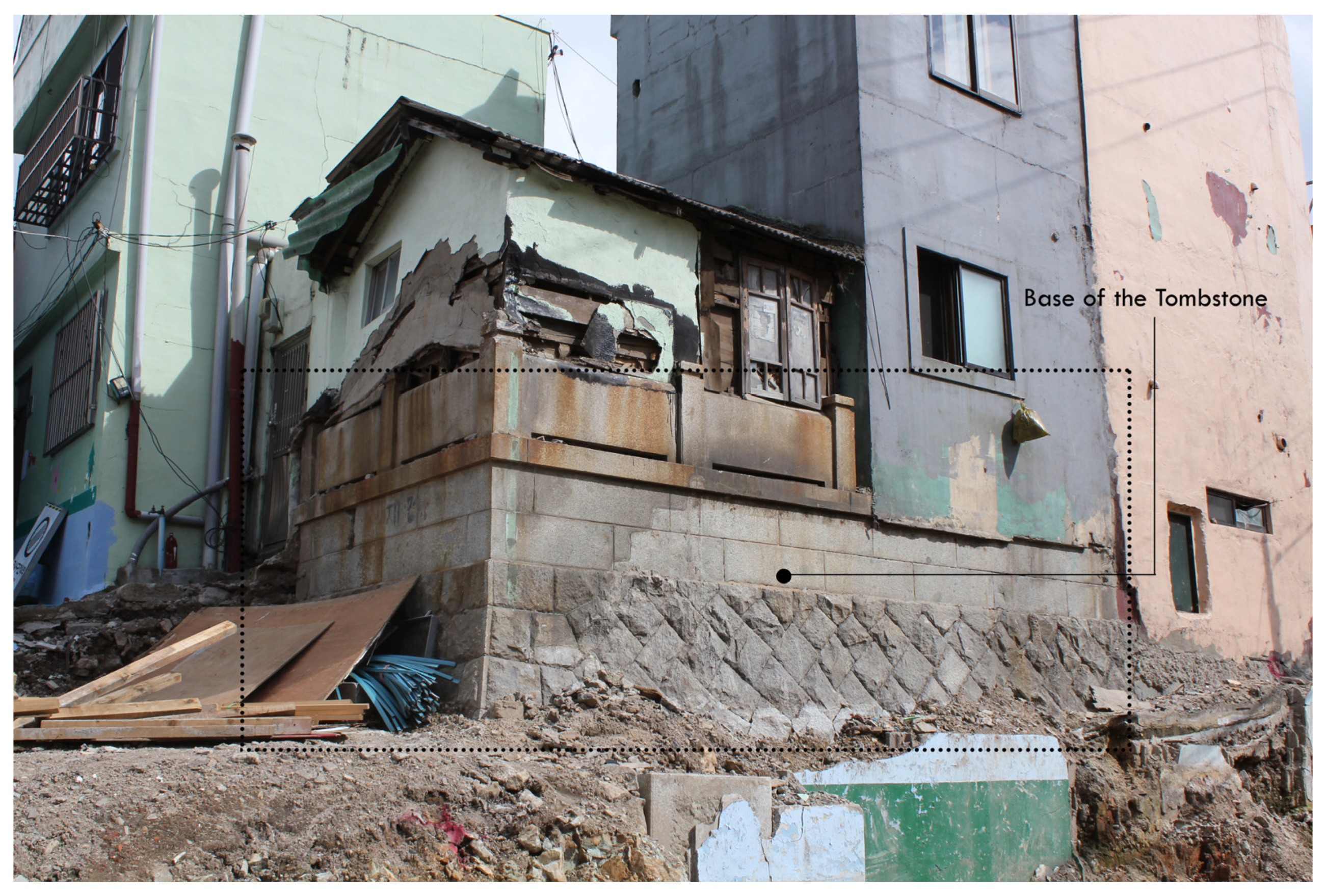
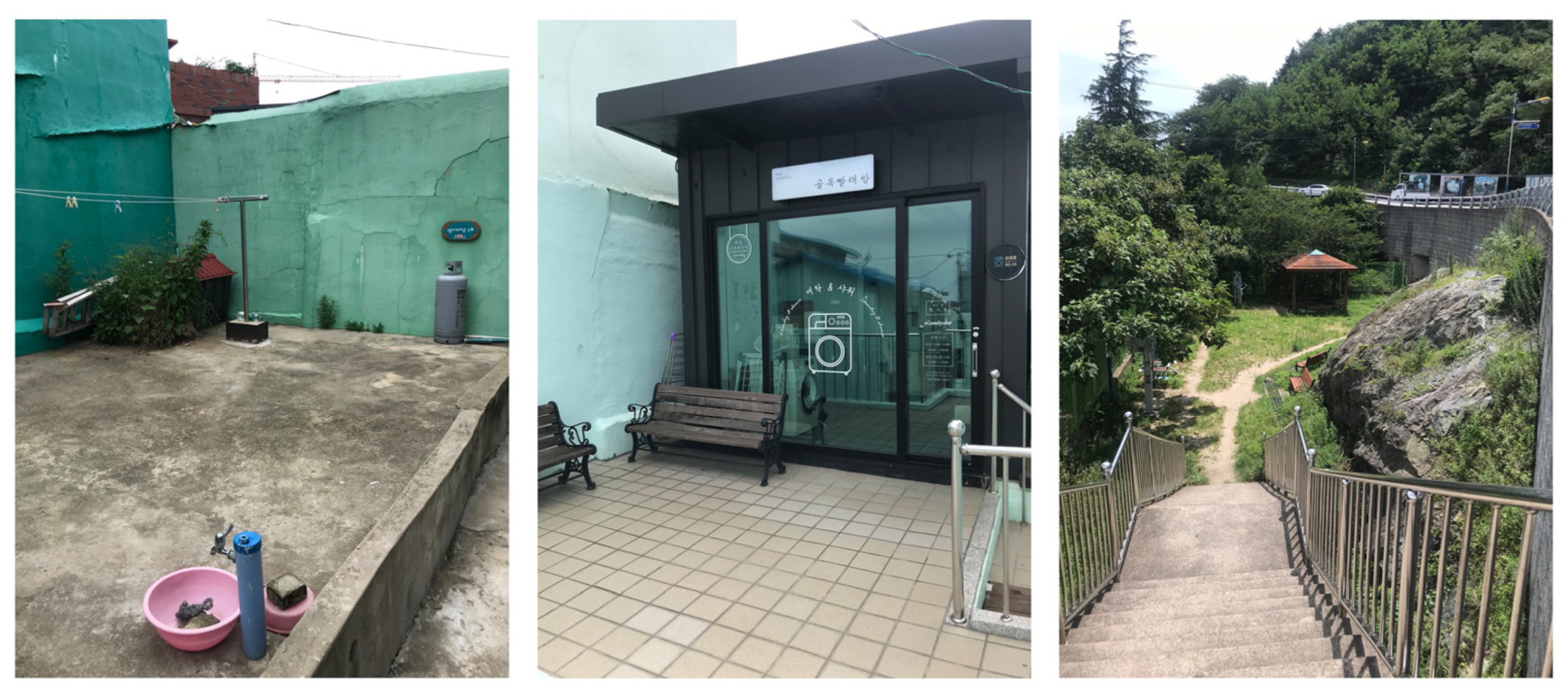

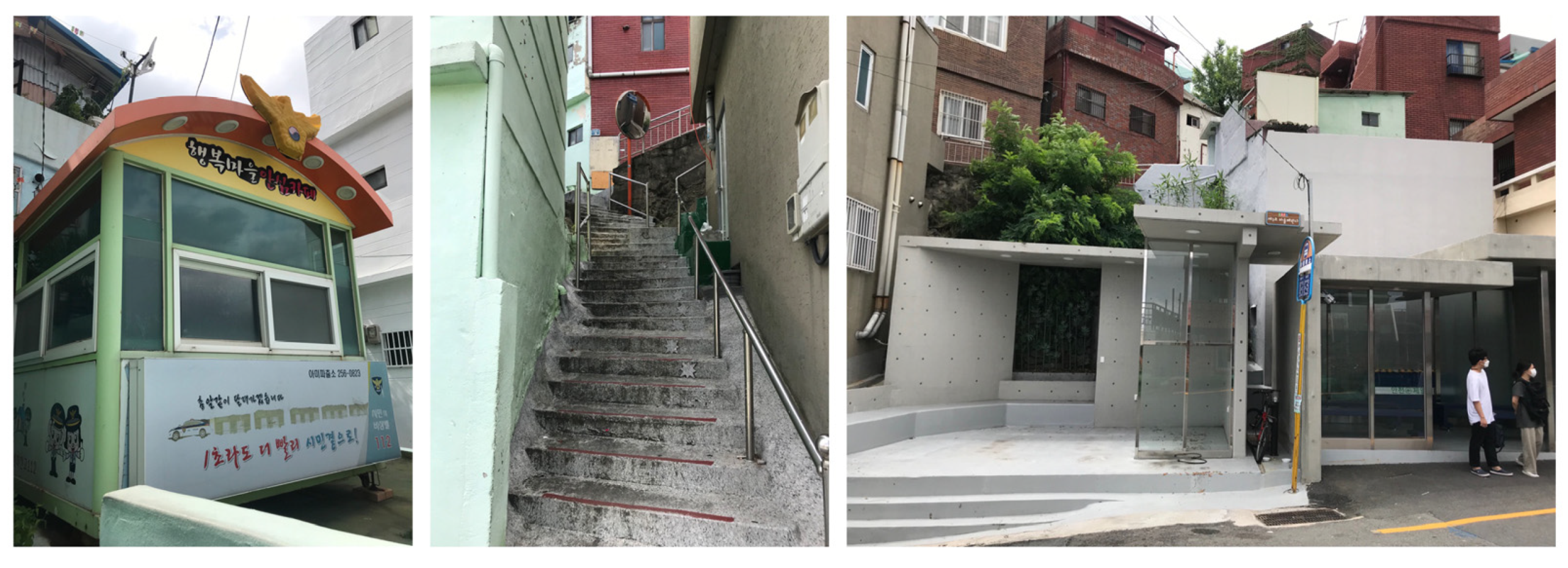
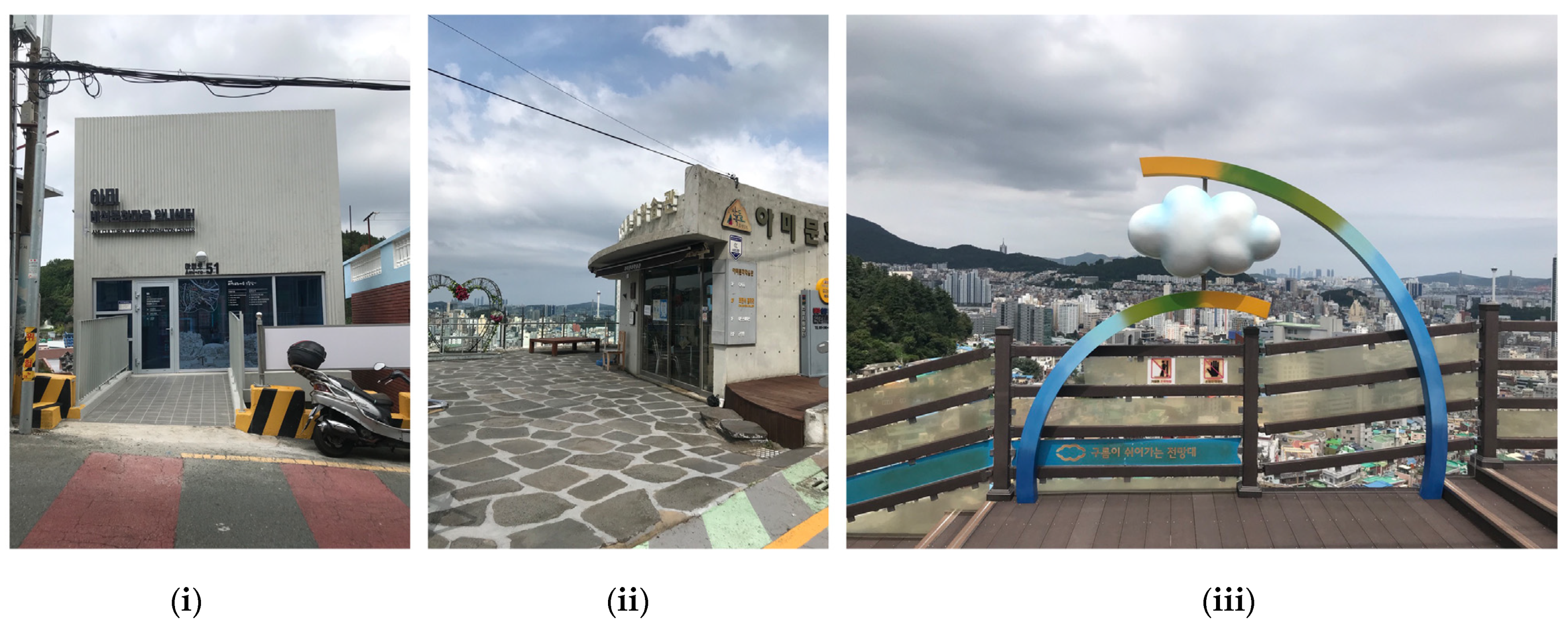
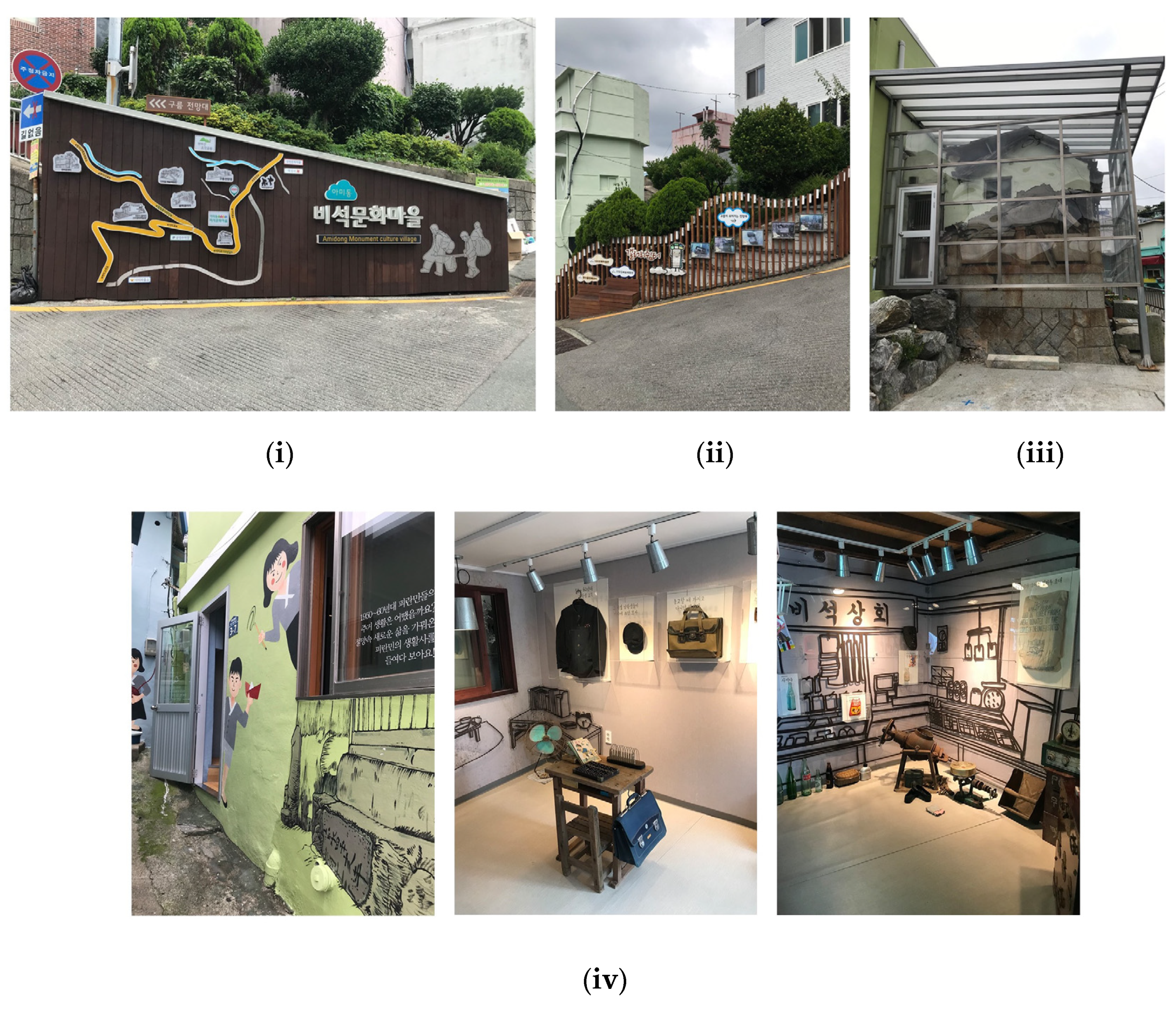
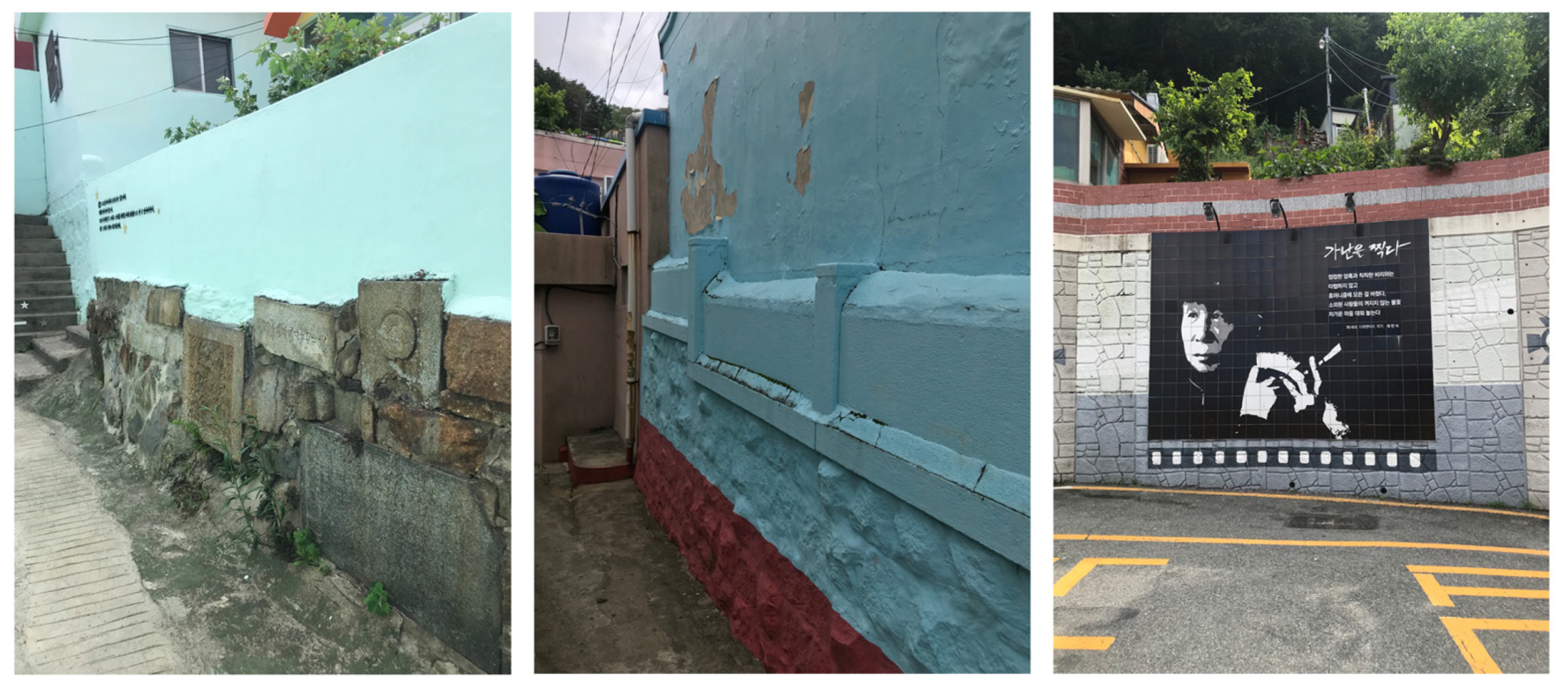

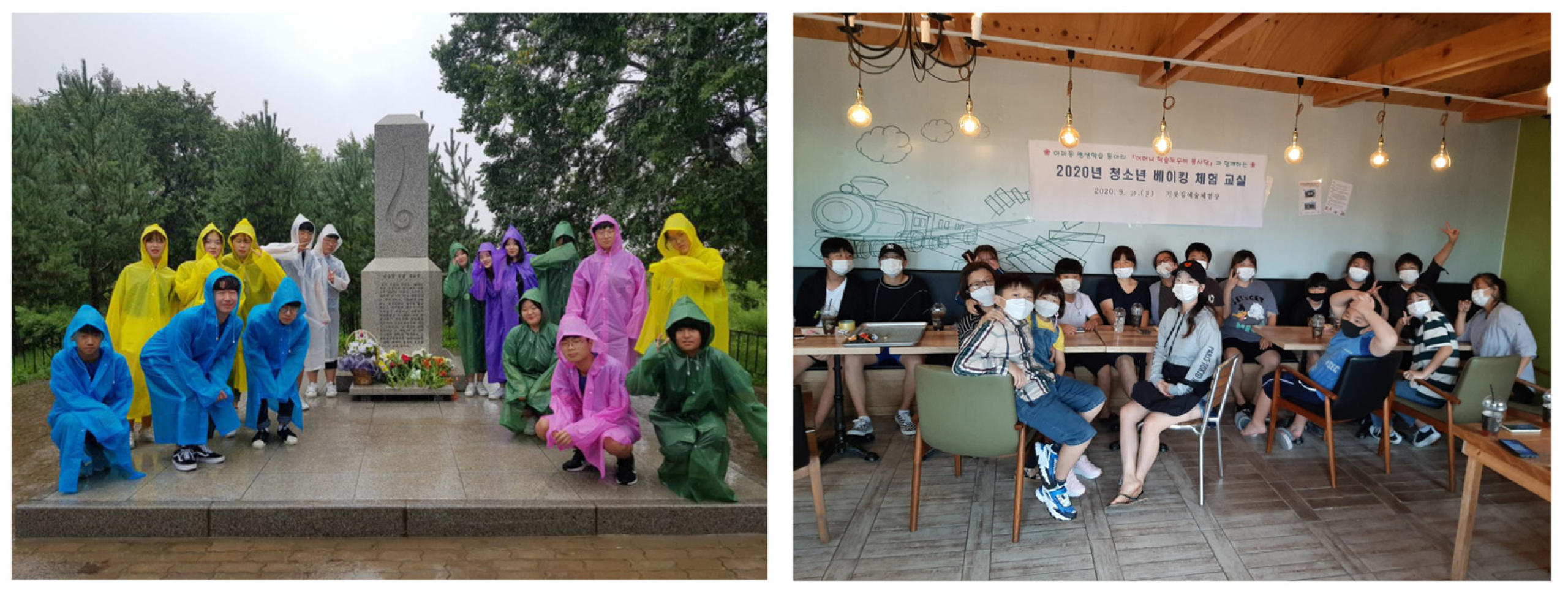
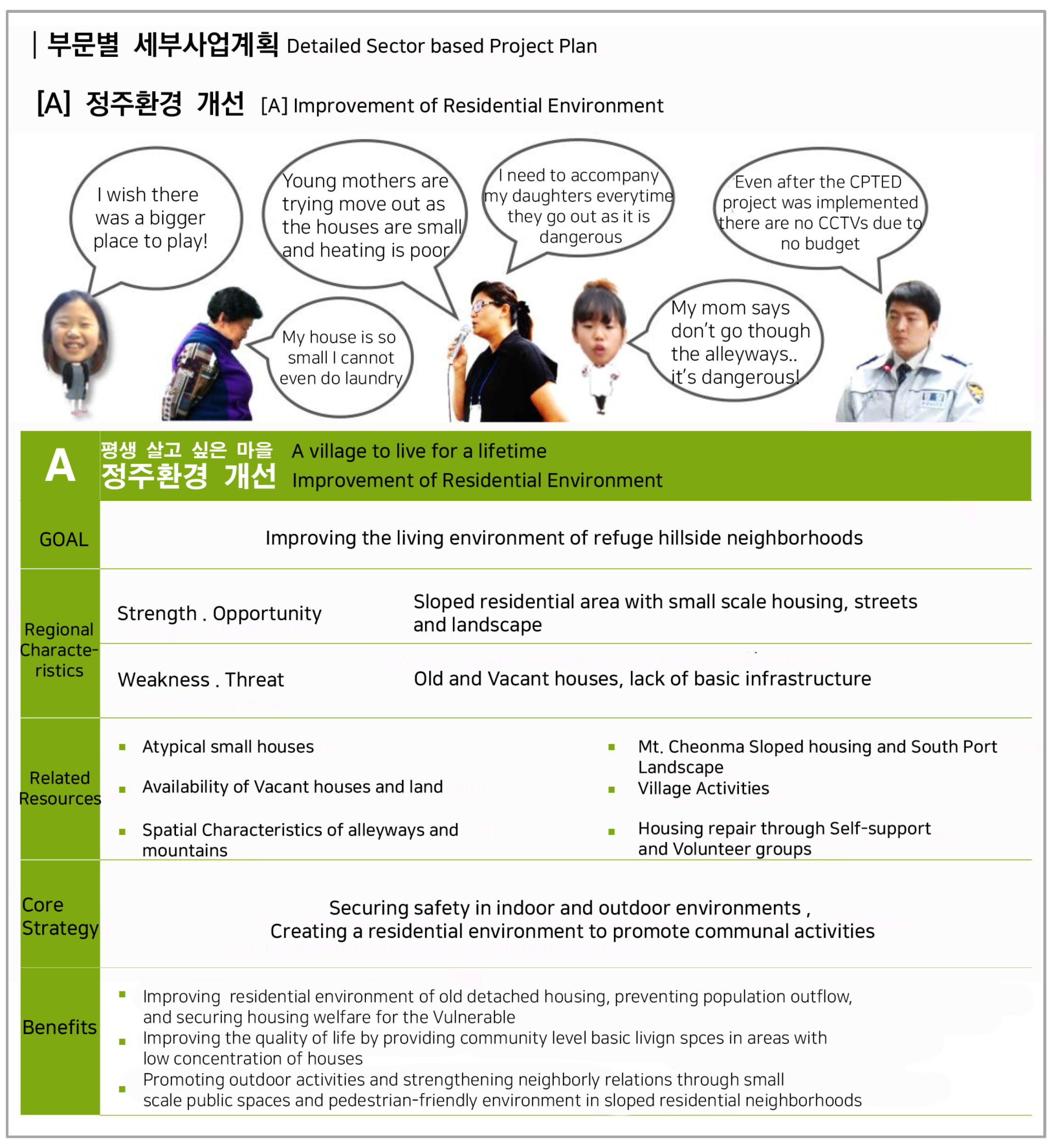
| Physical Regeneration | Social Regeneration |
|---|---|
| Community involvement and participation |
| Revival of social network |
| Collective activities |
| Daily routines and interactions |
| Safety and comfort (CPTED) |
| |
| |
| Cultural Regeneration | Economic Regeneration |
| Small businesses and local entrepreneurship |
| Tourism promotion—Dark tourism strategy |
| |
| |
|
Disclaimer/Publisher’s Note: The statements, opinions and data contained in all publications are solely those of the individual author(s) and contributor(s) and not of MDPI and/or the editor(s). MDPI and/or the editor(s) disclaim responsibility for any injury to people or property resulting from any ideas, methods, instructions or products referred to in the content. |
© 2023 by the authors. Licensee MDPI, Basel, Switzerland. This article is an open access article distributed under the terms and conditions of the Creative Commons Attribution (CC BY) license (https://creativecommons.org/licenses/by/4.0/).
Share and Cite
Konduri, S.; Lee, I.-H. Rethinking Sense of Place Interpretations in Declining Neighborhoods: The Case of Ami-dong Tombstone Cultural Village, Busan, South Korea. Societies 2023, 13, 30. https://doi.org/10.3390/soc13020030
Konduri S, Lee I-H. Rethinking Sense of Place Interpretations in Declining Neighborhoods: The Case of Ami-dong Tombstone Cultural Village, Busan, South Korea. Societies. 2023; 13(2):30. https://doi.org/10.3390/soc13020030
Chicago/Turabian StyleKonduri, Sreenidhi, and In-Hee Lee. 2023. "Rethinking Sense of Place Interpretations in Declining Neighborhoods: The Case of Ami-dong Tombstone Cultural Village, Busan, South Korea" Societies 13, no. 2: 30. https://doi.org/10.3390/soc13020030
APA StyleKonduri, S., & Lee, I.-H. (2023). Rethinking Sense of Place Interpretations in Declining Neighborhoods: The Case of Ami-dong Tombstone Cultural Village, Busan, South Korea. Societies, 13(2), 30. https://doi.org/10.3390/soc13020030








